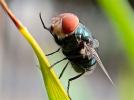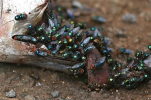army judge
Super Moderator


WACO, Texas (KWTX) - Here in Central Texas and across the state officials are now preparing for an outbreak of the New World screwworm, a parasite currently plaguing Mexico and South America.
Cochliomyia hominivorax, the New World screwworm fly, or simply screwworm or screw-worm, is a species of parasitic fly that is well known for the way in which its larvae eat the living tissue of warm-blooded animals. It is present in the New World tropics. Of the five species of Cochliomyia, only C. hominivorax is parasitic; a single parasitic species of Old World screwworm fly is placed in a different genus.
While the screwworm, which looks like a fly, may seem harmless it's a threat to any living, warm-blooded mammal.
The Texas Farm Bureau is one of many now keeping a close eye on the screwworm, which Tracy Tomascik explains has spread farther and farther North over the last couple of years.
According to Tomascik, "the New World screwworm is currently about 600 miles South of the Texas border in Mexico".
But what makes this fly such a concern? Doctor Sonja Swiger, an Entomologist with Texas AgriLife Extension, says screwworms will lay their eggs on living animals, which then hatch into larvae.
"They have these mouth hooks, they put those down into the tissue and kind of screw, in a sense, their way into the body," Dr. Swiger explained.
Attracting more flies that will lay more eggs, eventually killing the animal if left untreated.
"One female lays about two to three hundred eggs, so we have all this larva feeding onto this one animal," Dr. Swiger said, "so it's really that the system shuts down because it's being attacked".
And now that threat is moving right towards the state with the largest livestock industry in the U.S.
"All indications say that the pest is gonna continue moving North," Tomascik shared.
However, this wouldn't be the first time the state has dealt with a screwworm infestation.
"The last time that they were in the U.S. was in the 1970s and it took 30 something years to get that pest pushed out of Texas and then through Mexico and down to Panama," Tomascik recalled.
Killing hundreds of thousands of livestock, and costing the state millions of dollars.
"Today that moves up into the billions with not only the livestock industry, but also the tremendously important wildlife and hunting industry," he further explained.
How they eradicated the screwworm then is by releasing sterile male flies to break their life cycle, which is what they're doing now to hopefully stop the spread.
But both Dr. Swiger and Tomascik say it's still important to be prepared by educating yourself and keeping an eye out for any signs of an infestation.
"Increase the amount of time spent with your livestock, spent with your cats and dogs, and monitoring the health of those animals," Tomascik said.
"If you see something suspicious just report it," Dr. Swiger added.
Just last week Governor Abbott directed Texas Parks and Wildlife as well as the Texas Animal Health Commission to establish a new world screwworm response team to protect Texas livestock and wildlife.
For more information on how to identify a screwworm and how it's currently impacting our area click here.

Experts warn about the New World screwworm as the threat of a U.S. outbreak rises
Here in Central Texas and across the state officials are now preparing for an outbreak of the New World screwworm, a parasite currently plaguing Mexico and South America.

